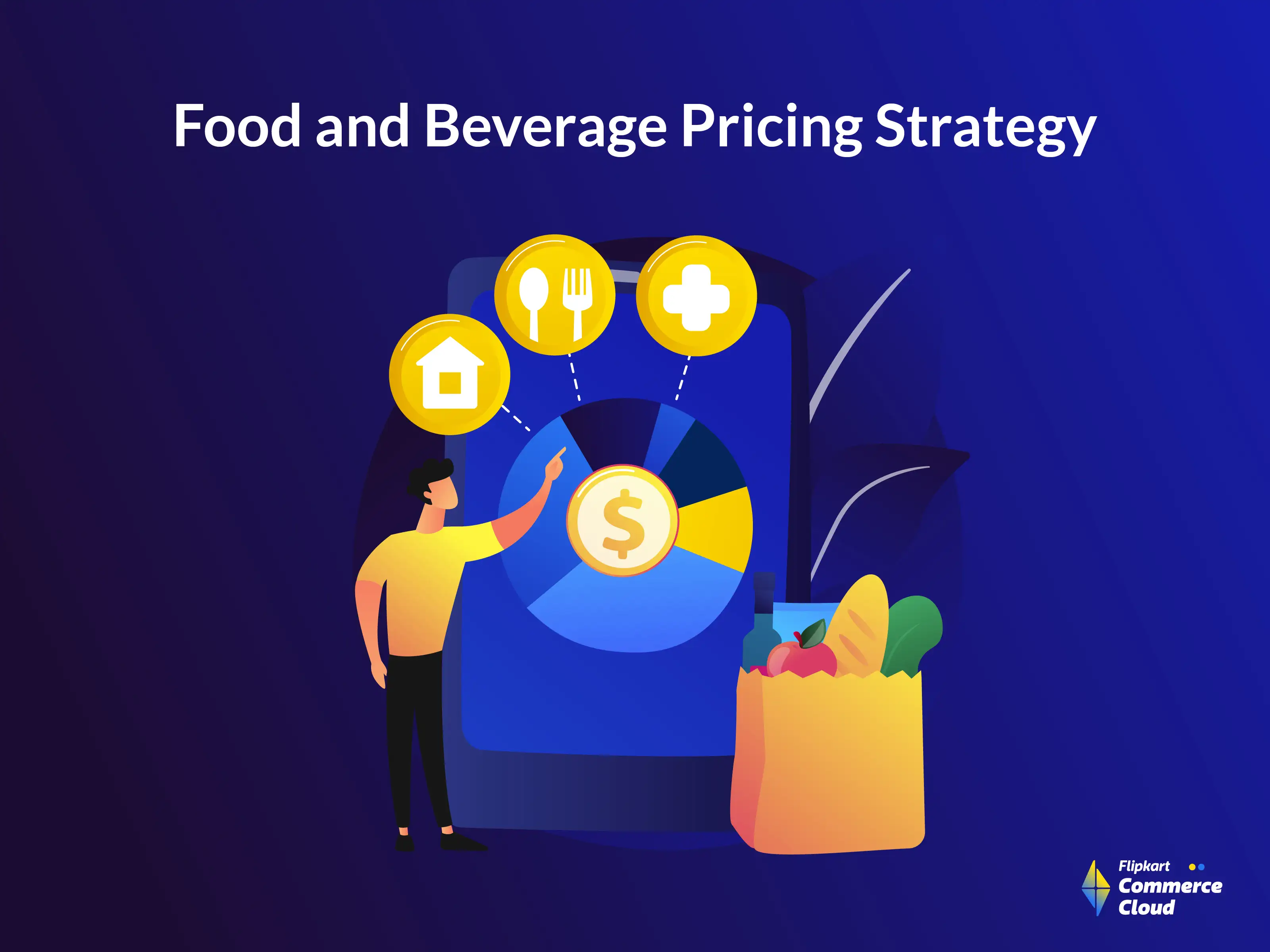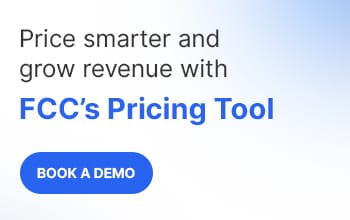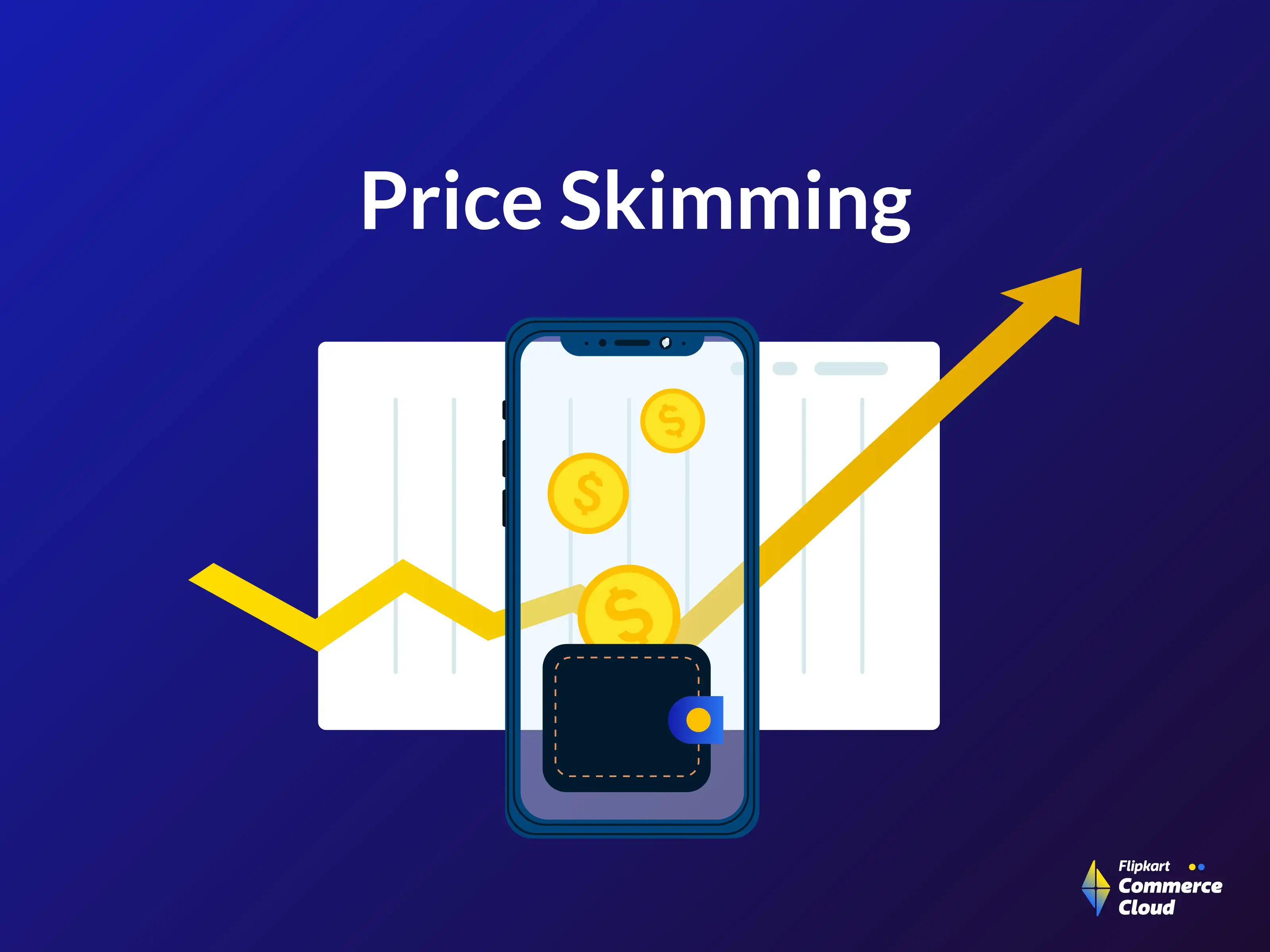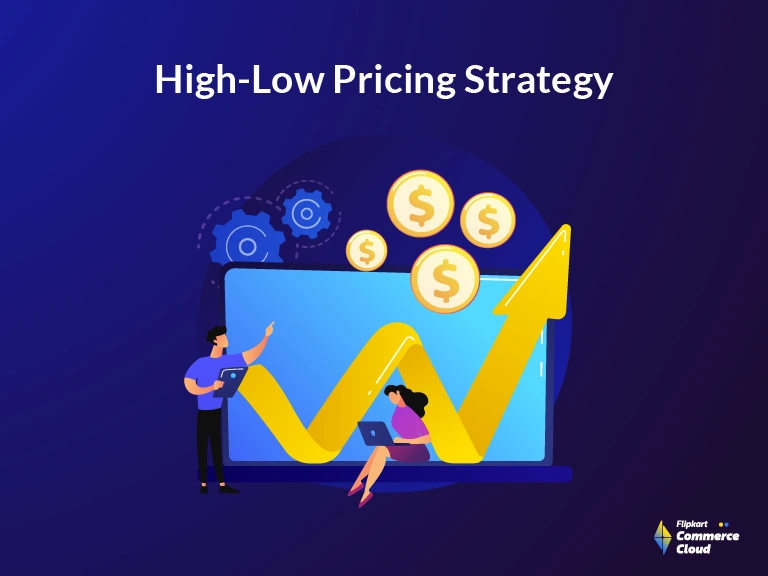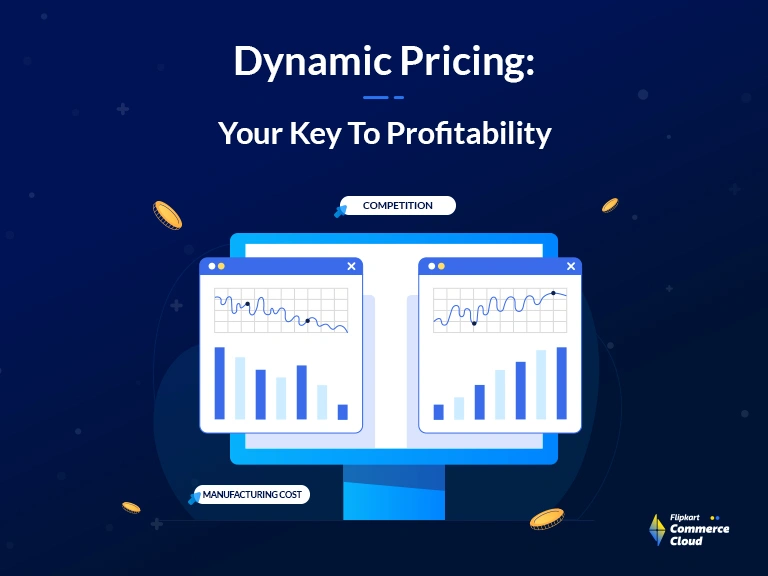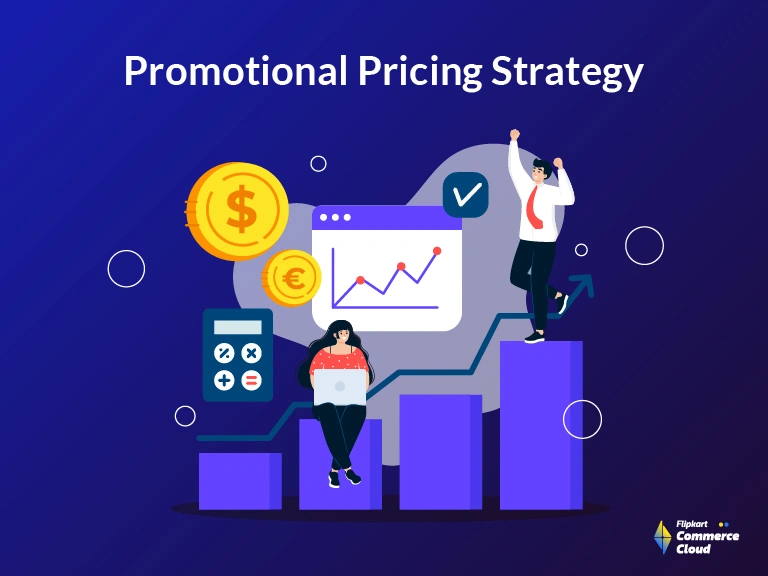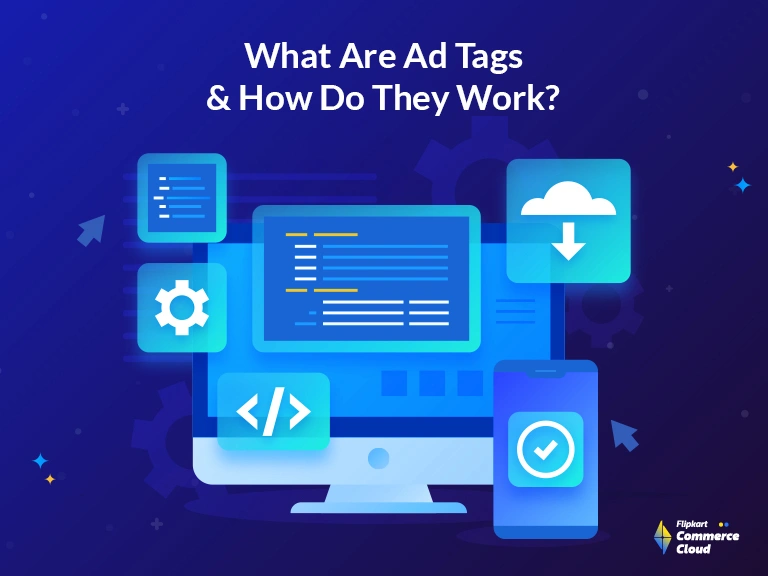In the highly competitive Food and Beverage industry, pricing strategies play an important role in ensuring profitability and revenue growth. With the right F&B pricing strategies, businesses can also establish a competitive advantage and foster positive customer perception.
This blog covers the essential aspects of a food and beverage pricing strategy, including its meaning, important factors, different pricing options, and best practices to follow.
What is a Food & Beverage Pricing Strategy?
A food and beverage pricing strategy is a methodical way of determining product prices that F&B businesses charge for their products. Unlike others, the food and beverage industry is guided by unique factors such as unstable supply chains, increasing food prices, labor shortages, and changing customer demands.
Therefore, it is important to consider several factors while determining the optimal pricing for your products.
Why Crafting a Pricing Strategy for Food and Beverage Challenging
Here are some challenges that the beverage and food industry struggles with when it comes to developing a robust pricing strategy:
- Perishability: Many food and beverage items often have a short shelf life, leading to potential waste and loss if not managed effectively. For instance, dairy products need to be sold quickly to avoid spoilage, requiring a dynamic pricing strategy that can respond to these time-sensitive conditions.
- Seasonal Demand: The demand for certain food and beverage items can fluctuate significantly with the seasons. This variability can make it difficult to follow a consistent pricing strategy. For example, the demand for ice cream typically increases in summer and decreases in winter, requiring a pricing strategy that can adapt to these seasonal shifts.
- Regulatory Requirements: This industry is subject to a host of regulations and standards, which can impact pricing. These can range from health and safety regulations to labeling requirements that vary across regions. All of these need to be factored into the pricing approach.
- Consumer Trends: Consumer preferences in the food and beverage industry can change rapidly. Keeping up with these trends and adjusting your pricing strategy accordingly can be a challenging task. For instance, the recent trend towards healthy and organic foods has forced many businesses to reassess their food pricing strategies, as health-conscious consumers are willing to pay a premium for such products.
- Supply Chain Disruptions: Fluctuations in commodity prices, supply chain issues, and increased competition can impact profit margins and pricing strategies. For instance, the cost of soybean oil, used in many foods, has skyrocketed, affecting the pricing of these products.
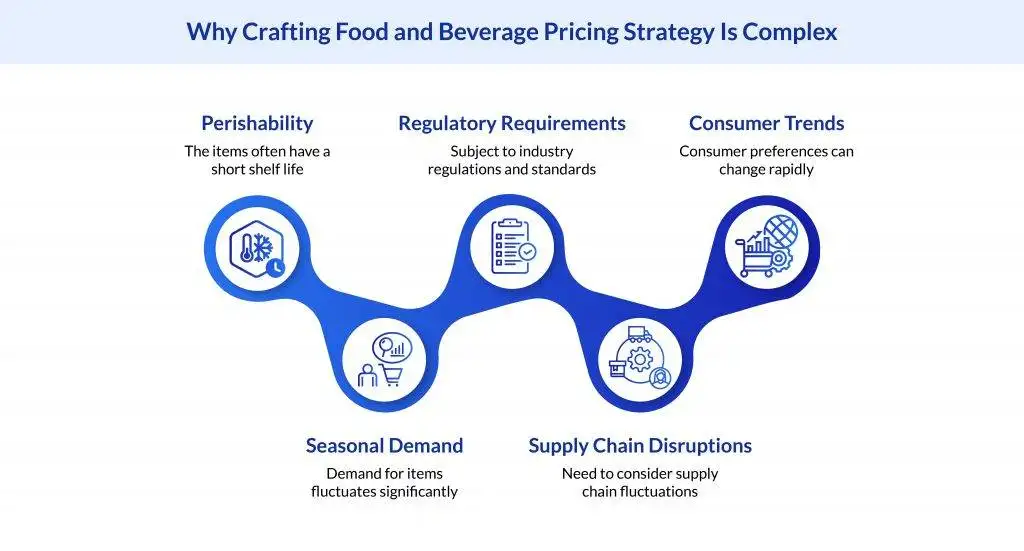
Factors to Consider for Food and Beverage Pricing
When formulating a food and beverage pricing strategy in a highly competitive market, you need to consider the following key factors:
- Price Consciousness: In the food and beverage industry, consumers often exhibit high price sensitivity. As per the International Food Information Council’s 2023 Food and Health Survey, 76% of individuals stated that price significantly impacts their food and beverage purchase decisions. Therefore, understanding your customers’ willingness to pay is essential when setting the prices.
- Competition: The competitive landscape can significantly shape your pricing method. If a competitor is offering a similar product at a lower price, customers might switch, affecting your market share. Hence, regular competitive analysis can help you position your products effectively and make informed pricing decisions.
- Cost Structure: Understanding your cost structure is fundamental to profitable pricing. This includes direct costs like raw materials and labor and indirect costs like rent, utilities, and marketing. For instance, the rise in commodity prices in 2021 led to increased costs for food manufacturers, impacting their costing approach.
- Distribution Channels: The channels you use to sell your products can also impact your pricing, as selling through online platforms might involve different costs (like shipping and platform fees) compared to physical stores. These costs must be incorporated into your food and beverage pricing strategy to ensure profitability across all channels.
Types of Food & Beverage Pricing Strategies
Effective pricing strategies can deliver a 2 to 7 percent increase in return on sales. However, manual implementation can lead to productivity issues, errors, and increased costs. As it involves significant effort with multiple internal stakeholders and potential impacts on various systems and processes.
Given the dynamic nature of the retail industry, you need a robust platform like Flipkart Commerce Cloud’s Pricing Manager to implement and monitor your pricing strategies. It automates and streamlines pricing decisions for retail – offline, online, and across channels. Our Pricing Manager is powered by the latest ML algorithms to handle vast amounts of data and optimize your pricing decisions according to the defined rules and guardrails.
Now, here are the most popular methods used by F&B businesses:
Discount Pricing Strategy
The discount pricing strategy is used to attract price-sensitive customers. It involves reducing the prices of products, either temporarily for promotional purposes or over an extended period. You can use this strategy to clear ageing stock, or simply increase sales volume.
While this strategy can attract customers and boost sales in the short term, you also need to consider its potential pitfalls. Frequent discounting can lead to a perception of lower quality, and customers may become conditioned to shop only at discounted prices, affecting sales during the regular period.
Discount Pricing Example: Costco is known for its discount pricing strategy, maintaining a consistent price of $4.99 for its rotisserie chicken, despite not profiting from these sales because it acts as a traffic driver to its stores.
Competitive Pricing Strategy
As a business working in the highly competitive food and beverage industry, you would often need to employ this pricing strategy. This method involves setting prices based on competitors’ pricing.
There are three main types of competitive pricing strategies you can choose from:
- Dismissive Pricing: It involves setting prices without considering competitors’ prices, focusing instead on your costs and desired profit margins. For example, a fine-dining restaurant might set higher prices based on the quality of its ingredients and the culinary experience it offers rather than what a competitive restaurant business is charging.
- Aggressive Pricing: This strategy aims to undercut competitors by setting lower prices. It is often used to gain market share or drive competitors out of the market. A classic example is how budget supermarkets like Aldi and Lidl price their products lower than traditional supermarkets to attract cost-conscious shoppers.
- Cooperative Pricing: Under this method, businesses in the same industry work together to set prices, which is often seen in industries with few players. This strategy is less common in the food and beverage industry due to antitrust laws and a large number of players, but it can be seen in some niche markets.
While competitive pricing can help you stay relevant in the market, always ensure that your prices cover costs and allow for a reasonable profit margin.
To streamline this process, you can leverage the advanced functionalities of FCC Pricing Engine’s Competitive Intelligence. This multi-layered, ML-powered module offers end-to-end integrated competitor crawling and matching with 98% precision to ensure a 3-5% uplift in your revenue. FCC Pricing Engine helps set the foundation for a robust pricing strategy by impacting four key aspects :
- Pricing: Track competitor’s prices at predefined frequencies, compare prices across multiple key vendors and bypass blockers on key competitors such as Amazon.
- Promotions: Track their promotions and promotional cycles at the SKU level and track the impact of offline promotions using dynamic labels.
- Availability: Monitor overall product availability and track geographically specific availability.
- Reviews: Monitor customer sentiment and overall rating of your competitor’s product at the SKU level.
Cost Plus Pricing Strategy
This straightforward approach involves calculating prices by adding a markup to the cost of goods sold. It is recognized for its simplicity and is widely used in the industry. In the cost-plus pricing strategy, you first calculate the total cost of production, which includes raw materials, labor, and overhead costs. Then, you add a markup percentage to this cost to determine the final selling price.
This pricing method is most effective when costs are predictable and the market is less price-sensitive. However, it is important to ensure that the markup reflects the value perceived by your customers and remains competitive in the market. For instance, a restaurant using premium and locally sourced ingredients might justify a higher markup in the final price compared to a fast food outlet.
The FCC Pricing Manager’s powerful rule-based pricing engine, coupled with an elaborate insights and analysis tool, is extremely helpful in ensuring seamless implementation of your cost plus pricing strategy.
Let’s consider an example to understand how you can set cost-plus pricing rules on Pricing Manager. Suppose you want to implement a cost-plus pricing strategy for all Key Value Items (KVI) where the new price is 20% above the latest cost but the discount is never above 50%. With FCC Pricing Manager, you can automate this process by fetching the latest cost of the product and setting a repricing rule to be 20% above the latest cost. You can also keep a guardrail with a cap target of 50% above the cost.
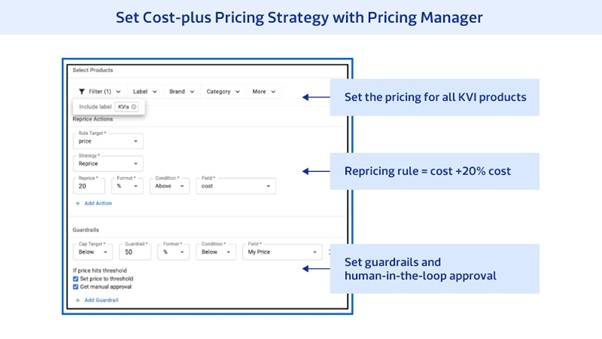
You can also go a step beyond and set complex cost-plus pricing scenarios with the FCC’s Pricing Manager. For example, assume you want to implement a pricing strategy that is as competitive as possible in the mobile phone category if the inventory is less than 50 units. For this, you can set a repricing rule where your product price undercuts your major competitor by 2% while ensuring prices are always 5% above cost.
Economy Pricing Strategy
The Economy Pricing Strategy is a cost-effective method for attracting customers who are mindful of their budget. This strategy focuses on setting prices low enough to still make a marginal profit per item. The idea is to sell your product to as many price-conscious customers as possible who are always on the lookout for good deals.
The success of this strategy hinges on controlling costs and achieving high-volume sales. To keep costs low, it is essential to streamline operations, minimize waste, and optimize the supply chain. Also, be vigilant over the cost of production and ensure you have sustained high-volume sales to offset the low-profit margins.
A classic example of economy pricing in action is Walmart’s ‘Everyday Low Prices’ strategy. By leveraging its vast supply chain and economies of scale, Walmart can offer low prices to its customers, making it a popular choice for budget-conscious shoppers.
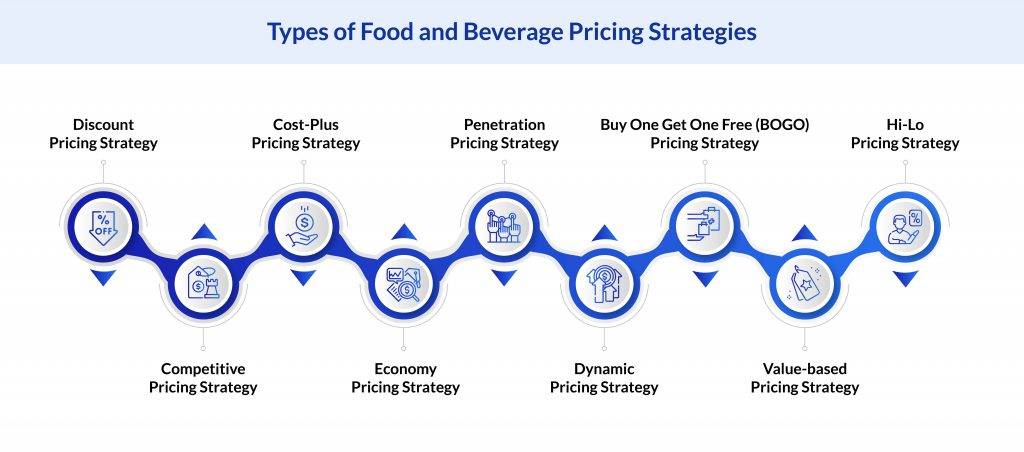
Penetration Pricing Strategy
The Penetration Pricing Strategy is a method often used when launching new products. The primary aim is to quickly gain a large market share by setting initial prices lower than the competition. This makes penetration pricing best suited for businesses with the financial stability to withstand initial lower profits.
You must pay attention to the following aspects here:
- Market Presence and Customer Attraction: This strategy can be effective when trying to establish a strong market presence. By setting low introductory prices, you can draw customers away from competitors and encourage them to try your new products.
- Price Increase and Customer Loyalty: Once a substantial customer base is established and strong customer loyalty is built, prices can be gradually increased. The goal is to reach a price point that maximizes profitability while still offering value to customers.
- Trade-Off and Financial Stability: This strategy involves a trade-off. While low prices can attract customers and build market share, they can also lead to reduced profits in the short term. Therefore, you must be willing to sacrifice initial profits for the potential of greater market share and long-term profitability.
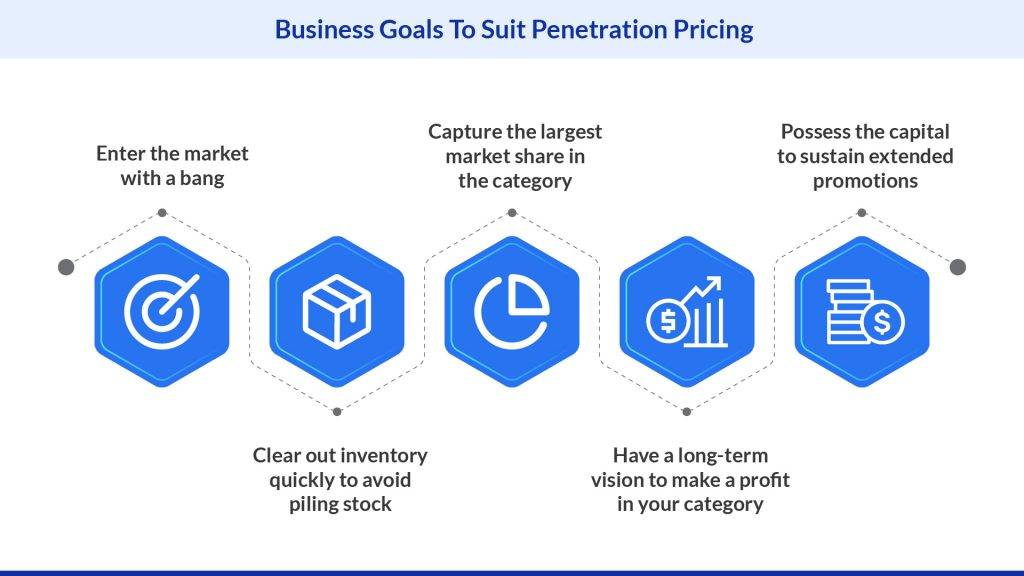
Dynamic Pricing Strategy
Dynamic pricing is a strategy that involves adjusting prices based on real-time market conditions and customer demand. This method is gaining traction in the food and beverage industry, which is increasingly facing challenges like inflation and high labor costs. Dynamic pricing can help improve profitability, customer satisfaction, and competitive advantage.
Technology and data analytics are crucial in implementing this strategy:
- Predictive Analytics: Advanced analytics tools can predict future demand based on historical data and market trends. This allows you to adjust prices in anticipation of demand surges or drops.
- Real-Time Data: Technology can enable you to collect and analyze real-time data about customer behavior, competitor prices, or external factors like weather and events. Real-time data allows you to adjust prices based on market conditions dynamically.
Dynamic pricing software like Flipkart Commerce Cloud’s Pricing Manager can automate price adjustments. Once the pricing rules, strategies, and guardrails are set, prices can be automatically adjusted based on the predefined rules.
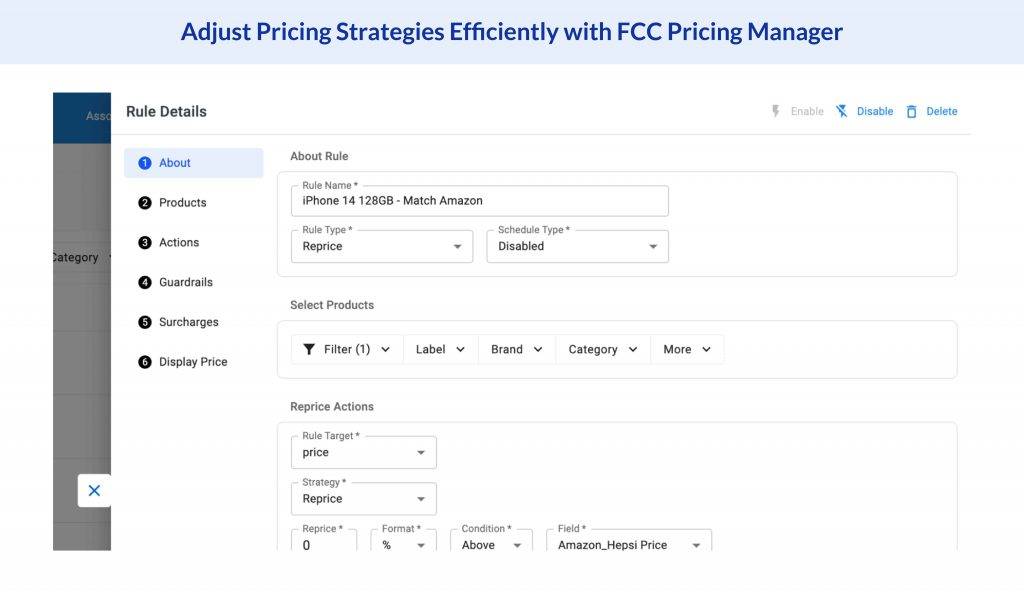
Dynamic pricing is most effective in situations where demand fluctuates significantly, such as during peak dining hours in restaurants or seasonal rushes in grocery stores. By adjusting prices in real-time, you can maximize your revenue during high-demand periods and attract customers during off-peak times.
Buy One Get One Free (BOGO) Pricing Strategy
The Buy One Get One Free (BOGO) pricing strategy is a popular promotional method in the F&B industry. It encourages customers to purchase a higher quantity by offering free products. This pricing strategy can be highly effective in increasing sales and clearing inventory. For instance, a grocery store might offer a BOGO deal on a product that is nearing its expiration date to minimize waste.
However, implementing a BOGO strategy requires careful planning and analysis:
- What: Determine which products are suitable for a BOGO offer. These could be products with a high-profit margin, overstocked items, or products nearing their expiration date.
- When: Timing is crucial for a successful BOGO offer. Consider factors like seasonality, holidays, and peak shopping times. For example, offering a BOGO deal on ice cream during the summer season can boost sales.
- How: Decide how often to run BOGO promotions. Frequent promotions might lead customers to wait for these deals, affecting regular sales. On the other hand, infrequent promotions might not have a significant impact on overall sales.
Value-based Pricing Strategy
Value-based pricing is a strategy where you set prices based on the perceived value to customers. You need to conduct market research, customer surveys, and data analysis to gain insights into what customers value and how much they are willing to pay for it.
Unlike cost-plus or competitive pricing, this method focuses on the customer’s perception of value rather than the cost of production or what the competition is charging.
In the F&B industry, value can be derived from various factors such as quality of ingredients, health benefits, brand reputation, and even the dining experience. For instance, a restaurant might charge a premium for dishes made with organic, locally sourced ingredients because customers perceive these dishes as healthier and more sustainable.
Hi-Lo Pricing Strategy
The Hi-Lo pricing strategy involves setting regular prices high (Hi) and then offering frequent promotions or discounts (Lo) to attract customers. This strategy can create a sense of urgency among customers to buy products while they are on sale. It can also generate excitement and increase the number of visitors during promotional periods.
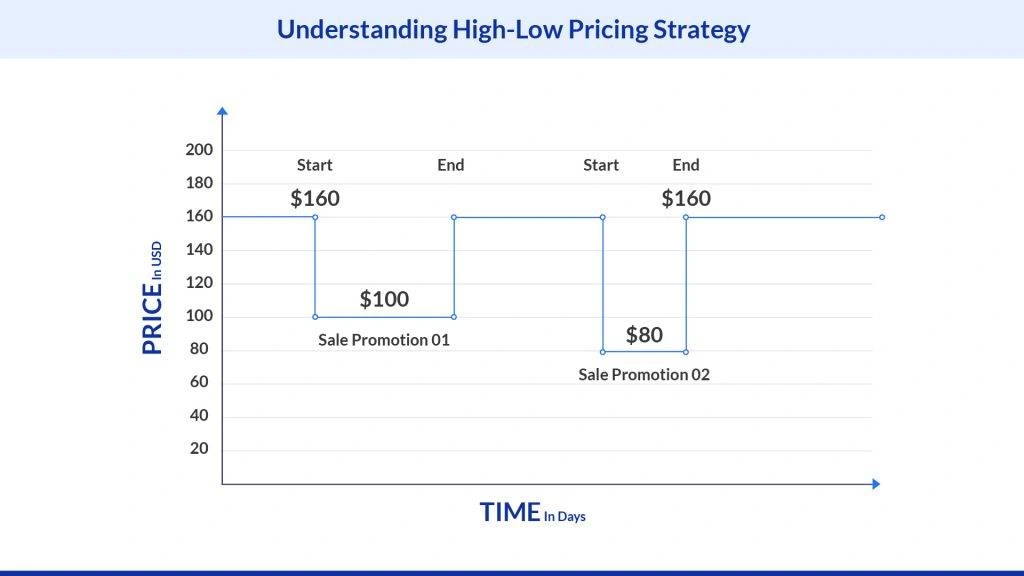
With the Hi-Lo pricing strategy, you need to ensure that the high regular prices do not deter customers and that the discounts do not erode profit margins. It is also important to manage customer expectations, as frequent discounts can result in customers buying the products only during sales. This can result in extremely low sales volumes during the regular period.
Despite these challenges, the Hi-Lo pricing strategy can be effective in driving sales and managing inventory, especially for perishable items.
Food and Beverage Pricing Strategy: Examples
To understand the workings of a food and beverage pricing strategy in the real world, here are two important case studies:
McDonald’s Pricing Strategy
McDonald’s, the world’s largest chain of fast-food restaurants, employs a well-calibrated blend of value pricing, market adaptation, and data-driven decisions. McDonald’s maintains its position as an affordable, fast, and convenient dining option by offering a limited, consistent menu, bundling products, and employing upselling tactics.
McDonald’s follows a thorough pricing mechanism for each nation to establish the price for a set market. Without compromising the quality of their products, they determine a price target, identify demand, estimate the ideal food cost, and examine the expenses, pricing, and offers of rivals. McDonald’s also utilizes a penetrating pricing strategy that involves setting prices lower than the competitors to address barriers to entry and threats from new entrants.
Domino’s Pricing Strategy
Domino’s Pizza, a global leader in pizza delivery, has a well-thought-out marketing strategy that has set the company apart from its competitors. To enhance the value proposition for its customers, Domino’s routinely offers enticing specials and combo packages, allowing customers to try a range of menu items at a lower price.
Domino’s has a very competitive pricing for its pizzas. Since Domino’s has two major competitors (Pizza Hut and Papa John’s), which are almost equally or even more spread than it is, it must keep prices competitive. The prices are done in different ways with three sizes available, and the non-vegetarian pizzas are charged relatively higher than the vegetarian options.
Best Practices for Customer-Friendly F&B Pricing Strategy
Here are some key practices you should consider for creating a customer-friendly food and beverage pricing strategy:
Use Technology for Agility: Leveraging technology can help ensure your pricing strategy is agile and responsive to market changes. Advanced pricing software platforms like FCC Pricing Manager provide real-time competitor pricing data, allowing you to compare your prices with competitors. This feature can help you identify pricing opportunities, understand market trends, and make informed pricing decisions.
How Pricing Manager from Flipkart Commerce Cloud can help?
Our Pricing Manager is built on machine learning models based on demand elasticity and principles of game theory to help ensure consistent pricing performance across categories.
It considers your past sales performance, competitor’s data and inputs like promotion frequencies, product quality, and market conditions to forecast Gross Merchandise Volume (GMV) at every price point and find the best price within the pricing rules.
The module further employs a game theory model that simulates all possible outcomes for each price and then selects the price that is most likely to generate the highest profit.
Understand Key Value Drivers: Not all products contribute equally to your bottom line. Understanding which products are driving the key value is crucial for effective pricing. This involves analyzing sales data to identify high-performing products and setting prices that maximize their profitability.
FCC Pricing Manager transforms this process by using a data-driven approach to identify your KVIs. Analyzing extensive transaction data identifies items that significantly impact customer price perception and overall sales volume.
The process of selecting KVIs with the FCC Pricing Manager involves analyzing transaction data and shopping carts, gaining a sense of how shoppers perceive prices, and considering your expertise. This all-around strategy helps you identify products that shape customers’ perceptions, motivate them to shop more often and encourage them to add more items to their carts.
Combine Different Pricing Strategies: There is no one-size-fits-all pricing strategy. The most effective approach often involves bundling different pricing strategies for optimal results. For instance, you might use cost-plus pricing for some products and value-based pricing for others, depending on their cost structure and perceived value.
The FCC Pricing Engine offers comprehensive solutions to optimize pricing strategies. It helps you understand how each product is being priced, all in one central platform. By setting product filters based on text and numeric conditions, you can create specific pricing strategies for particular product groups.
For example, you can select products sold by a specific brand or select only products with an inventory age greater than, let’s say, 80 days. Once the products are selected, you can formulate specific repricing logic to generate a new price for every category.
The Pricing Engine also enables you to build custom formulaic logic using any client or competitor data and combine multiple logic in a single strategy. This way, you can be on top of your pricing decisions with approvals and guardrails.
Try Flipkart Commerce Cloud to Streamline Your F&B Pricing Strategy
Managing your food and beverage pricing strategy can be challenging. It is like navigating a complex maze where every turn can significantly impact your business. Flipkart Commerce Cloud (FCC) is your trusted guide in this journey. We offer a robust suite of tools and services, including the FCC Pricing Manager, designed to effectively assist businesses in streamlining their pricing strategies.
With the FCC Pricing Manager, you get a comprehensive suite of pricing software to cater to your diverse needs.
- Rule-based Pricing allows you to set custom rules for pricing your products.
- Pricing Optimization uses advanced algorithms to optimize your prices for maximum profitability.
- Competitive Pricing helps you track and analyze competitor pricing in real time.
Our pricing software can handle over 2 million price changes per hour, guaranteeing no pricing errors and preventing up to 77% of potential losses. Businesses using Flipkart Commerce Cloud have experienced sales increases between 3% and 5% and margin improvements of 4% to 7%.
Want to improve your pricing with FCC? Book a free consultation with our retail expert.
